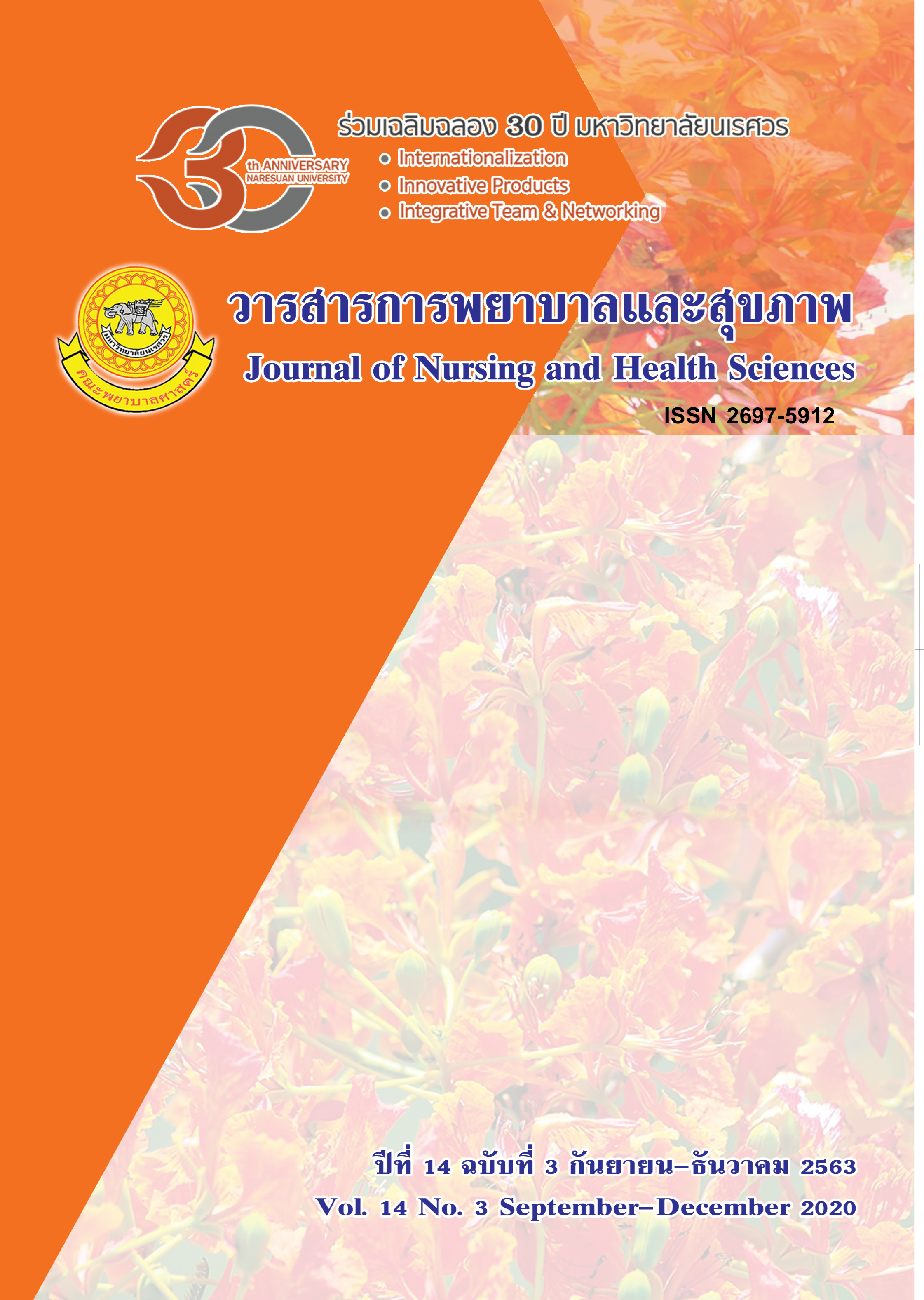Construct Modeling Approach and Its Applications in Nursing Research
Main Article Content
Abstract
โมเดลภาวะสันนิษฐานให้ความสำคัญกับการแปลความผลการวัดอย่างมีความหมาย โดยวิธีการวัดภาวะสันนิษฐานเรียกว่า “ระบบการประเมินแบบ 4 หน่วยโครงสร้าง” ประกอบด้วย 1) แผนที่ภาวะสันนิษฐาน เป็นแผนภาพแสดงโครงสร้างของตัวแปรเชิงทฤษฎี มีการกำหนดคุณลักษณะที่ต้องการวัดด้วยข้อมูลเชิงปริมาณและข้อมูลเชิงคุณภาพ แผนที่ภาวะสันนิษฐาน ประกอบด้วย แผนที่ภาวะสันนิษฐานของกลุ่มตัวอย่างและแผนที่ภาวะสันนิษฐานของการตอบสนองในแต่ละลำดับขั้นของคุณลักษณะ 2) การออกแบบข้อคำถาม โดยออกแบบเซทของข้อคำถามและการตอบสนองต่อข้อคำถามตามการกำหนดในแผนที่ภาวะสันนิษฐาน 3) การสร้างเกณฑ์การให้คะแนน เป็นการจัดกลุ่มของค่าสังเกต มีการกำหนดค่าคะแนนและแนวทางการให้คะแนนของค่าสังเกตซึ่งเป็นคุณลักษณะที่ต้องการวัดสอดคล้องกับรายละเอียดที่กำหนดไว้ในแผนที่ภาวะสันนิษฐาน และ 4) โมเดลการวัด เป็นการวิเคราะห์คำตอบของกลุ่มตัวอย่างตามทฤษฎีการตอบสนองข้อสอบโดยใช้โมเดลการวัดในตระกูลราสซ์โมเดลที่มีการแสดงพารามิเตอร์ระดับความสามารถของผู้ตอบและพารามิเตอร์ของข้อสอบในรูปของกราฟบนสเกลเดียวกันที่เรียกว่า “Wright Maps” ข้อดีของการประยุกต์ใช้แนวคิดโมเดลภาวะสันนิษฐานในงานวิจัยทางการพยาบาลโดยนำไปใช้ในการพัฒนาเครื่องมือวิจัยตามขั้นตอนของ 4 หน่วยโครงสร้าง ได้แก่ การสร้างแผนที่ภาวะสันนิษฐาน การออกแบบเครื่องมือวัด การกำหนดค่าคะแนนและการสร้างเกณฑ์การให้คะแนน และการวิเคราะห์คำตอบด้วยโมเดลการวัดตามทฤษฎีการตอบสนองข้อสอบ
Article Details

This work is licensed under a Creative Commons Attribution-NonCommercial-NoDerivatives 4.0 International License.
References
Adams, R. J., & Wu, M. L. (2010). Modelling a
dichotomously scored multiple choice test with
the rasch model. Retrieved 27 October 2015
from https://www.acer.edu.au/files/ConquestTutorial-1- RASCHModel Multiple Choice Test.
pdf.
Briggs, D. C., Alonzo, A. C., Schwab, C., & Wilson, M.
(2006). Diagnostic assessment with ordered
multiple-choice items. Educational Assessment,
(1), 33-63.
Cappelleri, J. C., Lundy, J. J. & Hays, R. D. (2014).
Overview of classical test theory and item response
theory for quantitative assessment of items in
developing patient reported outcome measures.
National Institutes of Health public access.
Clinical Therapeutics Journal,36(5), 648-662.
Chansakul, S. (2018). Comparison of cognitive diagnosis
results between construct maps and three-tier
diagnostic test of the nursing process in
fundamental nursing, Doctoral dissertation
(Education measurement and evaluation),
Chulalongkornuniversity, Bangkok. [In Thai].
Draney, K. (2009). Designing learning progressions with
the BEAR assessment system. Paper presented
at the Learning Progressions inn Science (LeaPS)
conference. Iowa City. IA.
Grazer, N. (2011). The use of construct maps in
understading 7th grade students’ learning of chemical
reaction. Doctoral dissertation (Education),
University of Michigan, United States of America.
He, Q. & Wheadon, C. (2012). The effect of sample
size on item parameter estimation for the
partial credit model. Centre for education research
and policy, AQA, 1-16
Heesch, K. C., Masse, L. C. & Dunn, A.L. (2006).
Usingrasch modeling to re-evaluate three scales
related to physical activity: enjoyment, perceived
benefits and perceived barriers. Health education
research theory & practice, 21(1), 58-72.
Holster, T. A. & Lake, J. W. (2015). From raw scores to
rasch in the classroom. Shiken, 19(1), 32-41.
Morell, L., Collier, T., Black, P. & Wilson, M. (2017).
A construct-modeling approach to develop a
learning progression of how students understand
the structure of matter. Journal of research in
science teaching, 54(8), 1024-1048.
Rezaee, R., Shafiayan, M., Jafari, P. & Zarifsaiey, N.
(2018). Invariance of item difficulty parameter
estimates based on classical test theory and item
response theory, Journal of advanced pharmacy
education & research, 8(2), 156-161.
Ryan, D. D. (2007). Measurement of student nurse
performance in the safe administration of
medication. Doctoral dissertation. Faculty of the
graduate school of Emory university.
Suksiri, W. (2014). Construct Mapping: An Approach
of Cognition Modeling in Valid Assessment
Systems. Journal of Research and Curriculum
Development, 4(1), 47-66. [In Thai].
Suksiri, W. & Worain, C. (2016). Investigating tentative
cutscores for science learning area on the
ordinary national educationaltest scores using
the construct mapping method: an analysis for
further judgments, National institute of educational
testing service (Public organization). [In Thai].
Wilson, M. (1992). The ordered partition model:
An extension of the partial credit model. Applied
Psychological Measurement,16(4), 309-325.
Wilson, M. (2005). Constructing Measures: an item
response modeling approach. Lawrence Eribaum
Associates, Inc.
Wilson, M. (2008). Cognitive Diagnosis Using Item
Response Models. Journal of Psychology, 216(2),
-88.
Wilson, M. (2012). Responding to a challenge that
learning progressions pose to measurement
practice. Learning Progressions in Science: Current
Challenges and Future Directions, 317-343.
Wilson, M. & Lehrer, R. (2021). Improving learning: using
a learning progression to coordinate instruction
and assessment. Frontiers in education, vol.6, 1-19.
Wu, M. & Adam, R. (2007). Applying the rasch model to
psycho-social measurement: A practical approach.
Educational measurement solutions. Melbourne.


